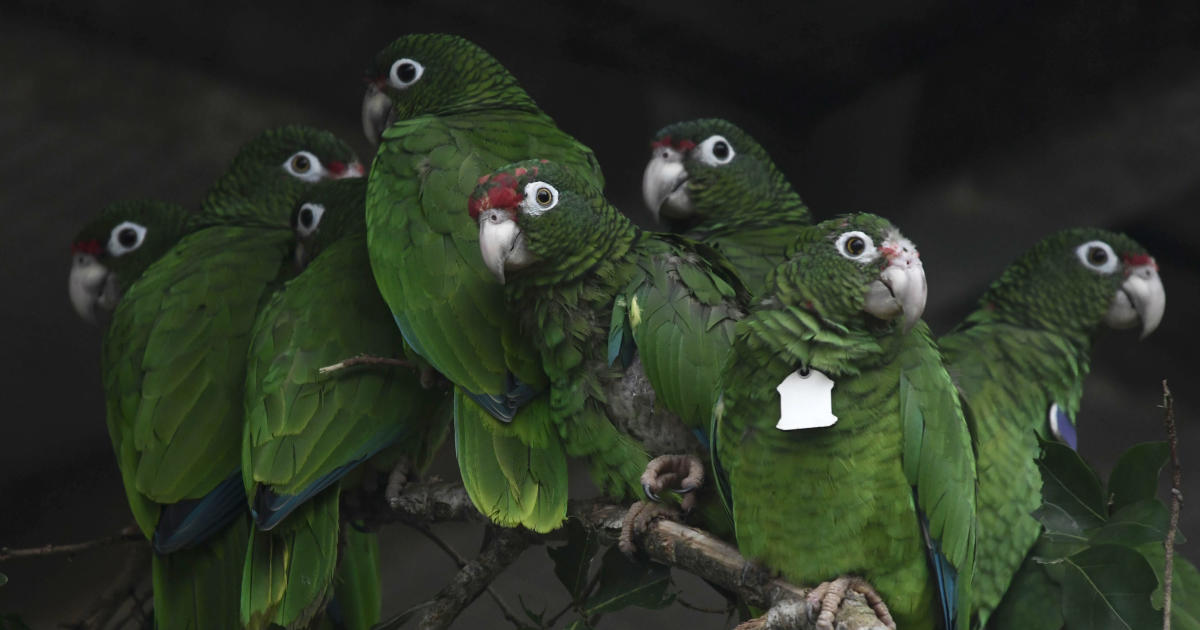Meet The Top 10 New Species Of 2018
CHICAGO (CNN) -- From the tops of a massive tree all the way to the bottom of the ocean, new species from around the world make the list for this year.
The new species include microbes, plants, animals and even the confirmation of an extinct marsupial, based on its fossil.
This is the 11th annual list compiled by the International Institute of Species Exploration, which is part of the State University of New York's College of Environmental Science and Forestry. The list is meant to highlight the diversity of species on our planet and to find them before they go extinct without us even knowing about them.
The bizarre selection comes from the institute's international committee of taxonomists, based on their picks from the 18,000 new species named in the year before. Though 18,000 sounds like a lot of new species, the college's president reminds everyone that an estimated 20,000 species go extinct each year.
"I'm constantly amazed at how many new species show up and the range of things that are discovered," Environmental Science and Forestry President Quentin Wheeler, founding director of the institute, said in a news release. "So many of these species -- if we don't find them, name them and describe them now -- will be lost forever. And yet they can teach us so much about the intricacies of ecosystems and the details of evolutionary history. Each of them has found a way to survive against the odds of changing competition, climate and environmental conditions. So each can teach us something really worth knowing as we face an uncertain environmental future ourselves."
The list pops up every May 23 in honor of the 1707 birth of the "father of modern taxonomy," Swedish botanist Carolus Linnaeus.
Here are the new species.
Protist (Ancoracysta twista)
Location: An aquarium in San Diego
This single-celled protist was found living on a brain coral in a tropical aquarium at the Scripps Institution of Oceanography -- so its origin in the wild remains unknown. This organism isn't an animal, plant or fungus but a eukaryote. Its genetic material exists in a nucleus that's bound in a membrane. The new species doesn't fit with any other known groups of protists. This predator uses a whip-like flagellum to move and has organelles like harpoons to help it feed on other protists. The scientific name is derived from the twisting motion that helps the protist swim.
Atlantic forest tree (Dinizia jueirana-facao)
Location: Brazil
At 130 feet in height, the top of this 62-ton tree can be seen above the canopy of Brazil's Atlantic Forest, which is home to half of the threatened species in Brazil. Yet it's slightly smaller than its sister species that can be found in the Amazon Rainforest. It bears woody fruit that can be 18 inches long. The critically endangered species can be traced to only 25 trees, half of which are in a protected area. The forest once spanned 330 million acres, but only about 15% of it remains pristine. The scientific name is derived from the local name for the tree.
Amphipod (Epimeria Quasimodo)
Location: Antarctic Ocean
This crustacean's humped back is why it's named for Quasimodo the hunchback from Victor Hugo's 1831 novel "Notre-Dame de Paris." It's only 2 inches long and lives in chilly waters south of the Polar Front. This is just one of 26 species belong to the same genus of crustacean that are abundant in the Antarctic Ocean, known for their bright colors.
Baffling beetle (Nymphister kronaueri)
Location: Costa Rica
No, it's not a character from the Harry Potter series, even if it sounds like one. Instead, this tiny beetle -- only 1.5 millimeters long -- lives alongside a species of nomadic army ant. Every two to three weeks, when the ant colony moves, so do the beetles. And much like an imposter, this beetle's body is exactly the same size, shape and color of the ants'. When the ants move to a new location, the beetles use their mouths to latch on to the abdomen of the ant and let it do all of the work. Because their abdomens are identical, it looks like the ant has two abdomens when a beetle is riding it. The beetles have a chemical signal that keeps them from becoming prey, but the scientists haven't quite worked out that signature. It's named for Daniel Kronauer, a field biologist who studies army ants and discovered the species.
Tapanuli orangutan (Pongo tapanuliensis)
Location: Sumatra, Indonesia
Great apes are hard to find, and this one was no exception. And this is the most endangered great ape in the world. The males are under 5 feet in height, and the females are under 4 feet, which is similar to other orangutans. Scientists estimate that there are only 800 of these living over 250,000 fragmented acres in hills and forests. Their isolated population is different from other species of Sumatran and Bornean orangutans. This particular species probably diverged from those other species about 3.38 million years ago. The name is inspired by the different areas it lives in.
Swire's snailfish (Pseudoliparis swirei)
Location: Western Pacific Ocean
This fish, which looks more like a tadpole, lives at the bottom of the Mariana Trench and is the deepest confirmed fish in the sea. It was discovered living between 22,000 and 26,000 feet below the surface. (It is believed that fish cannot survive below 27,000 feet.) Only about 4 inches in length, this predator was attracted to traps baited with mackerel. The name can be traced to one of the officers from the HMS Challenger, which discovered the trench in 1875.
Heterotrophic flower (Sciaphila sugimotoi)
Location: Ishigaki Island, Japan
This gorgeous flower, which presents small blossoms in September and October, lives in symbiotic harmony with a fungus. While most plants capture energy from the sun to grow and go through photosynthesis, this flower receives nutrition from the fungus without harming it. It only reaches about 4 inches in height and is critically endangered, with only about 50 plants found in two spots on Ishigaki Island. It is named for Takaomi Sugimoto, who found and collected the first examples of the flower.
Volcanic bacterium (Thiolava veneris)
Location: Canary Islands
Volcanoes beneath the ocean can kill off marine ecosystems, and that's exactly what happened when Tagoro erupted off the coast of the Canary Islands in 2011. Water temperature increased, oxygen decreased, and carbon dioxide and hydrogen sulfide were released. It's only fitting that a strange kind of proteobacteria would flourish in this toxic environment three years later. Named "Venus' hair," the bacteria formed a white mat making up nearly half an acre around Tagoro's volcanic cone. The structures look like hair but are really bacterial cell structures that have been encased in a sheath. These bacteria are helping set the stage for a new ecosystem.
Marsupial lion (Wakaleo schouteni)
Location: Australia
About 23 million years ago in Australia, a marsupial lion lived in the open forest and spent part of its life in trees. The omnivore weighed about 50 pounds and increased in size as the climate became drier and cooler. The species was discovered using fossils found in Queensland's Riversleigh World Heritage Area. It is named for noted paleoartist Peter Schouten.
Cave beetle (Xuedytes bellus)
Location: China
Beetles that live in caves often look nothing like actual beetles because they've had to adapt. This one was found in a cave in Guangxi province, and southern China is home to many caves and ground beetles. This cave beetle, named for beauty (as in the eye of the beholder), adapted to have long spider-like legs, a compact body and no flight wings, eyes or pigmentation. It's only half an inch in length and has a dramatically elongated head.



